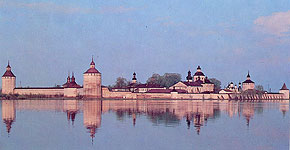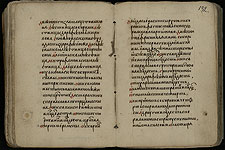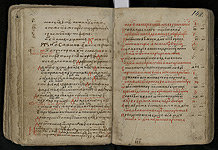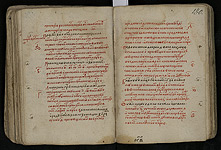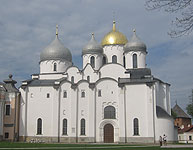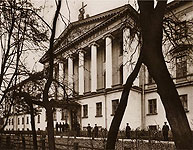Miscellany-convolute
The «Life of St. Sergius of Radonezh» has come down to us in a collection of readings written by the hand of Pachomius the Serb. This manuscript is one of numerous Old Russian miscellanies that were produced in monastery scriptoria. Monasteries were the major book centers in medieval Russia where manuscripts were composed, copied by rewriting and carefully stored. The miscellany is noteworthy not only for its contents but also for the fact that its history "ties" three largest book centers of Old Russia - the Trinity Monastery of St. Sergius, the Kirillo-Belozersky Monastery (St. Cyril of Beloozero's Monastery), and the Saint Sophia Cathedral in Novgorod.
Our miscellany is a convolute. Manuscripts comprising several individual works separately created by several scribes at different times, that are subsequently bound together, are called "convolutes". For some time, the manuscript could be kept and used unbound, "in quires", ie, in the form in which it came from the pen of the scribe.Old Russian scribe himself drew the lines on the pages of medieval manuscripts to write evenly, folded the sheets in quires, as well as numbered each quire. The number may appear on its first page or, sometimes, on the back of the last. These loose gatherings had to be collected up and held together in some binding. When the manuscript received its binding, the quire numbers served as a guide for a bookbinder. They helped him to place the sections in their correct order to make up a book.
Some quire numbers contained in our volume prove that it was composed of several sections. The main partion of the book, including the Collection of Works of Cyril of Jerusalem, the Gospel of Nicodemus, the Life of Sts. Constantine and Helen, The Life of St. John of Damascus, was rewrote in 1441 by Oleshko Pavlov (or Palkin). It is believed that this famous scribe was a teacher of St.Martinian of Beloozero - a follower of St. Therapont who founded the Ferapontov Monastery (Monastery of St. Therapont) gained the world fame for its frescoes painted by Dionysius. This major bulk of writings was bound together with works copied by other scribes who remained unknown. The remarkable autograph of Pachomius the Serb was discovered among these supplements.
The «Life of St. Sergius of Radonezh» consists of six quires numbered by the hand of Pachomius the Serb. The first folio of each quire carries a consecutive number on its recto side, while the last folio have the same number on its verso side. Outside leaves of quires turned more durty than the rest. This indicates that the manuscript rewritten by Pachomius Logothetes was kept unbound for a while. Most likely, Pachomius the Serb copied it at the Trinity Monastery of St. Sergius. This assumption was confirmed by research data when the paper was examined. In the 15th century Russia, there was no manufactories producing paper - it was imported from abroad and fairly expensive.
Medieval manuscripts are written on watermarked paper having unique filigrees - translucent images which can be viewed when the paper is held up to the light. The paper with different water marks were sold in different places. Information of where the paper with some filigree was used, can help to trace the place of the creation of the manuscript.A special study showed that filigrees discovered on the folios of the autograph of Pachomius the Serb are not found in other parts of the miscellany. However, the same water marks can be seen in the manuscript by Symeon the Theologian, rewritten by Pachomius Logothetes in 1442 at the Trinity Monastery of St. Sergius (selfmark: RGB, the Trinity-Sergius Lavra collection, no. 180). So, this paper was used in the Trinity Monastery of St. Sergius, where Pachomius the Serb worked.
Collection of Autographs and Oldest Russian Library Catalogue
How did it happen that the autograph of Pachomius the Serb was found in the miscellany from the Kirillo-Belozersky Monastery (St. Cyril of Beloozero's Monastery)? The history can be reconstructed in the following way. When visiting the Trinity Monastery of St. Sergius and consistently improving the writings of his predecessor Epiphanius the Wise, Pachomius the Serb finally composed the «The Life of St. Sergius of Radonezh» that seemed satisfactory to the author. Rewriting his own work, Pachomius sent it in quires to scribes of the Kirillo-Belozersky Monastery who had great authority. This "sending" is an evidence of the close relationship that existed between book centers in medieval Russia. The Kirillo-Belozersky Monastery received all new books of the time incredibly quickly. The scribes rewrote them to create their own copies. Such copy of the «Life of St. Sergius of Radonezh» sent by Pachomius the Serb was discovered in one of the manuscripts in the librarary of St. Cyril of Beloozero's Monastery (shelfmark: OR RNB, Kir.-Bel. 16/1255, fols. 179–227v.).The fact that our miscellany is well documented in the library of the Kirillo-Belozersky Monastery makes it extraordinarily valuable. Books were widely used in the daily life of the monastery - not only for worship, but also for a private reading in a monastic cell. All items were organized in a library by book material and their function. A unique document showing the development of "librarianship" in medieval Russia has been preserved as part of a celebrated miscellany by Herman Podolny, a holy elder of St. Cyril of Beloozero's Monastery (shelfmark: OR MFN Kir.-Bel 101/1178). In addition to an inventory of more than two hundred books of monastic library, the document contains the description of the contents of some manuscripts in two versions: rough and clean copies. This is the earliest extant catalogue of a Russian library. It is remarkable that our miscellany is listed in all three parts of the old catalogue - in the inventory, in rough and clean copies.
Catalogue of the Library of the Kirillo-Belozersky Monastery
The contents of our miscellany and its characteristics fully correspond to the description in the catalogue. The catalogue dated to the mid 80s of the 15th century, therefore, by this time our convolute had been already compiled and bound.
"Direct" access to the library had an ecclesiarch (an official in a church) who essentially performs the duties of a book keeper. An ecclesiarch had to choose readings for the every day liturgy service and for a refectory, so he could make the corresponding notes in the books, and probably, select and arrange material in the misellanies before binding. The first folio of our miscellany bears autographs of two prominent ecclesiarches. The holy elder Porphyry described the contents of the collection (fol. 1 v.). A list with an order of liturgical readings, made slightly later, (fol. 1) belongs to the hand of the famous scribe Euphrosynus. In the bottom margin, fol. 393 Euphrosynus marked in red cinnabar the number of leaves that John Chrysostom's essay contained. Obviously, the size of the work was important for the scribe because he was going to rewrite it. The copy made by Euphrosynus has survived in one of the miscellanies of the library of St. Cyril of Beloozero's Monastery (shelfmark: OR RNB, Kir.-Bel. 19/1258).
Miscellany - traveler
The «journey» of Pachomius the Serb' autograph did not end in St. Cyril of Beloozero's Monastery. The Miscellany- convolute compiled in the Kirillo-Belozersky Monastery, which included the autograph created at the Trinity Monastery of St. Sergius by Pachomius the Serb, subsequently came to the library of St. Sophia Cathedral of Novgorod.The libraries of St. Sergius and St. Cyril of Beloozero's monasteries dated back to the time period when their saint founders lived, i.e. from the 14th - early 15th centuries. However, the library of the St. Sophia Cathedral - is one of the first Russian book depositories. The St. Sophia Cathedral was built in Novgorod during the mid 11th century. The oldest surviving dated Russian manuscript book - the famous Ostrom Gospel (1056-1057 gg.)- was created for this temple. St. Sophia's library received books from the vast territory of north-western Russia. In the second half of the 18th century, the library was enriched with hundreds of books from monasteries abolished by the reform in 1764. In the 70s of the 18th century, Novgorod Metropolitan Gabriel strove to increase the holdings of St. Sophia's library. In 1780, more than 200 manuscripts were moved there from the Kirillo-Belozersky Monastery. Probably, among them was our miscellany - the convolute with Pachomius Logothetes' autograph.
Fate decreed that in the 19th century, the valuable manuscripts collections of north-western Russia were brought together in St. Petersburg. In 1859, the major portion of manuscripts from the Kirillo-Belozersky library, as well as the St. Sophia Cathedral was transferred to the St. Petersburg Theological Academy. In 1918-19, these collections came into the Manuscripts Department of the State Public Library (the former name of the National Library of Russia).


